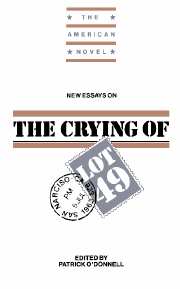Book contents
- Frontmatter
- Contents
- Series Editor's Preface
- 1 Introduction
- 2 Borges and Pynchon: The Tenuous Symmetries of Art
- 3 Toward the Schizo-Text: Paranoia as Semiotic Regime in The Crying of Lot 49
- 4 “Hushing Sick Transmissions”: Disrupting Story in The Crying of Lot 49
- 5 “A Metaphor of God Knew How Many Parts”: The Engine that Drives The Crying of Lot 49
- 6 A Re-cognition of Her Errand into the Wilderness
- Notes on Contributors
- Selected Bibliography
2 - Borges and Pynchon: The Tenuous Symmetries of Art
Published online by Cambridge University Press: 12 January 2010
- Frontmatter
- Contents
- Series Editor's Preface
- 1 Introduction
- 2 Borges and Pynchon: The Tenuous Symmetries of Art
- 3 Toward the Schizo-Text: Paranoia as Semiotic Regime in The Crying of Lot 49
- 4 “Hushing Sick Transmissions”: Disrupting Story in The Crying of Lot 49
- 5 “A Metaphor of God Knew How Many Parts”: The Engine that Drives The Crying of Lot 49
- 6 A Re-cognition of Her Errand into the Wilderness
- Notes on Contributors
- Selected Bibliography
Summary
Nostros (la indivisa divinidad que opera en nostros) hemos soñado el mundo. Lo hemos soñado resistente, misterioso, ubicuo en el espacio y firme en el tiempo; pero hemos consentido en su arquitectura tenues y eternos intersticios de sinrazón para saber que es falso.
—Jorge Luis BorgesYou can put together clues, develop a thesis, or several, about why characters reacted to the Tristero the way they did, why the assassins came on, why the black costumes. You could waste your life that way and never touch the truth.
—Driblette, The Crying of Lot 49In 1967 John Barth published an article inspired by his love for the Argentinean poet and short story writer Jorge Luis Borges entitled “The Literature of Exhaustion,” in which he set the Argentinean master into a more general context that included Joyce, Beckett, and Kafka. It is not necessary to review the history of the readings, rereadings, and misreadings of Barth's article, an appreciative reception that turned the “literature of exhaustion” into a critical commonplace. I would like, however, to note two rather interesting consequences of Barth's essay. First, while Borges was well known and much appreciated in Latin America both in his own right and as a precursor of the “Boom” writers of the 1960s, for many inhabitants of North America Barth's article revealed a startling new talent on the world literary scene.
- Type
- Chapter
- Information
- New Essays on The Crying of Lot 49 , pp. 21 - 46Publisher: Cambridge University PressPrint publication year: 1992



